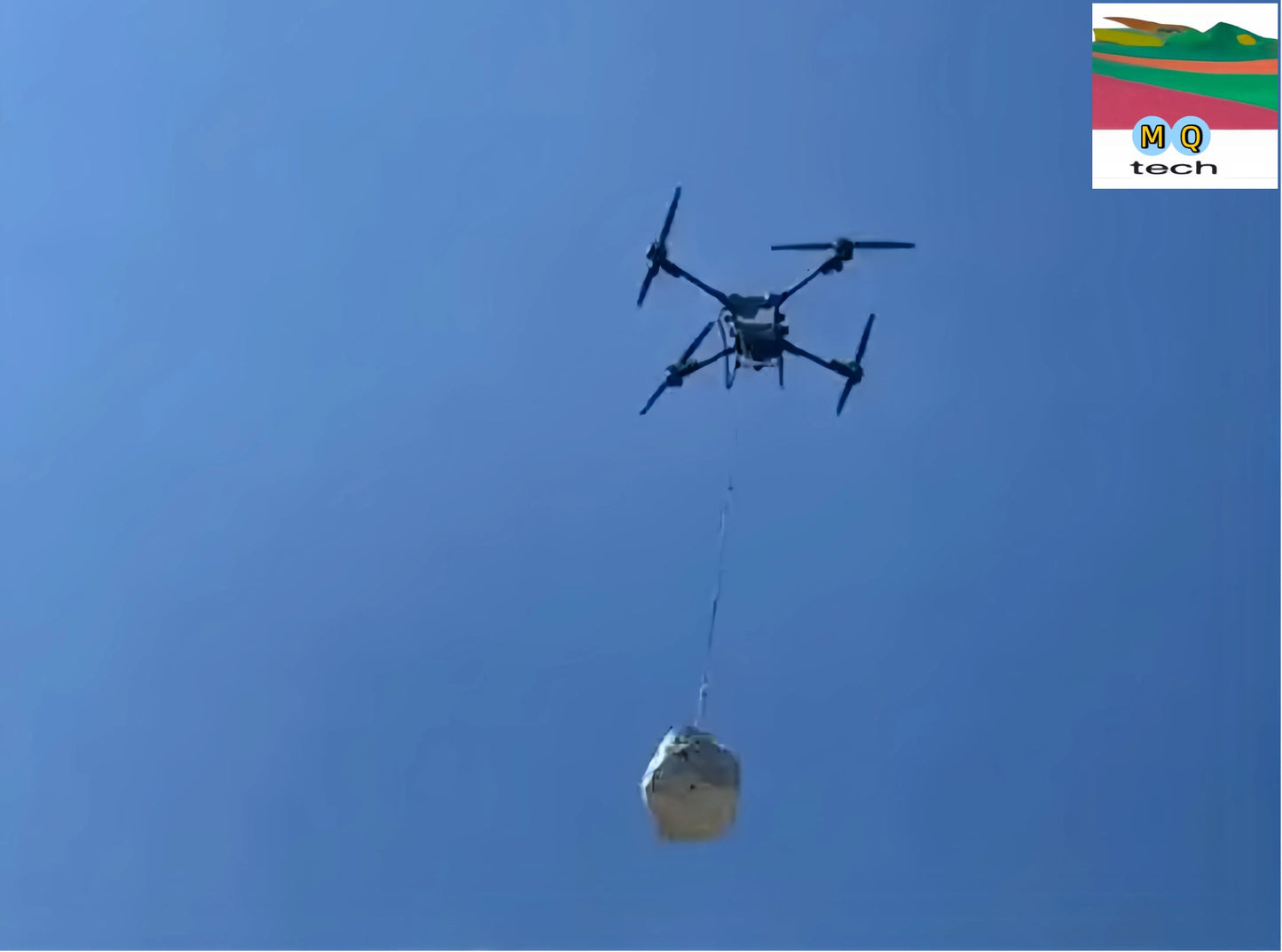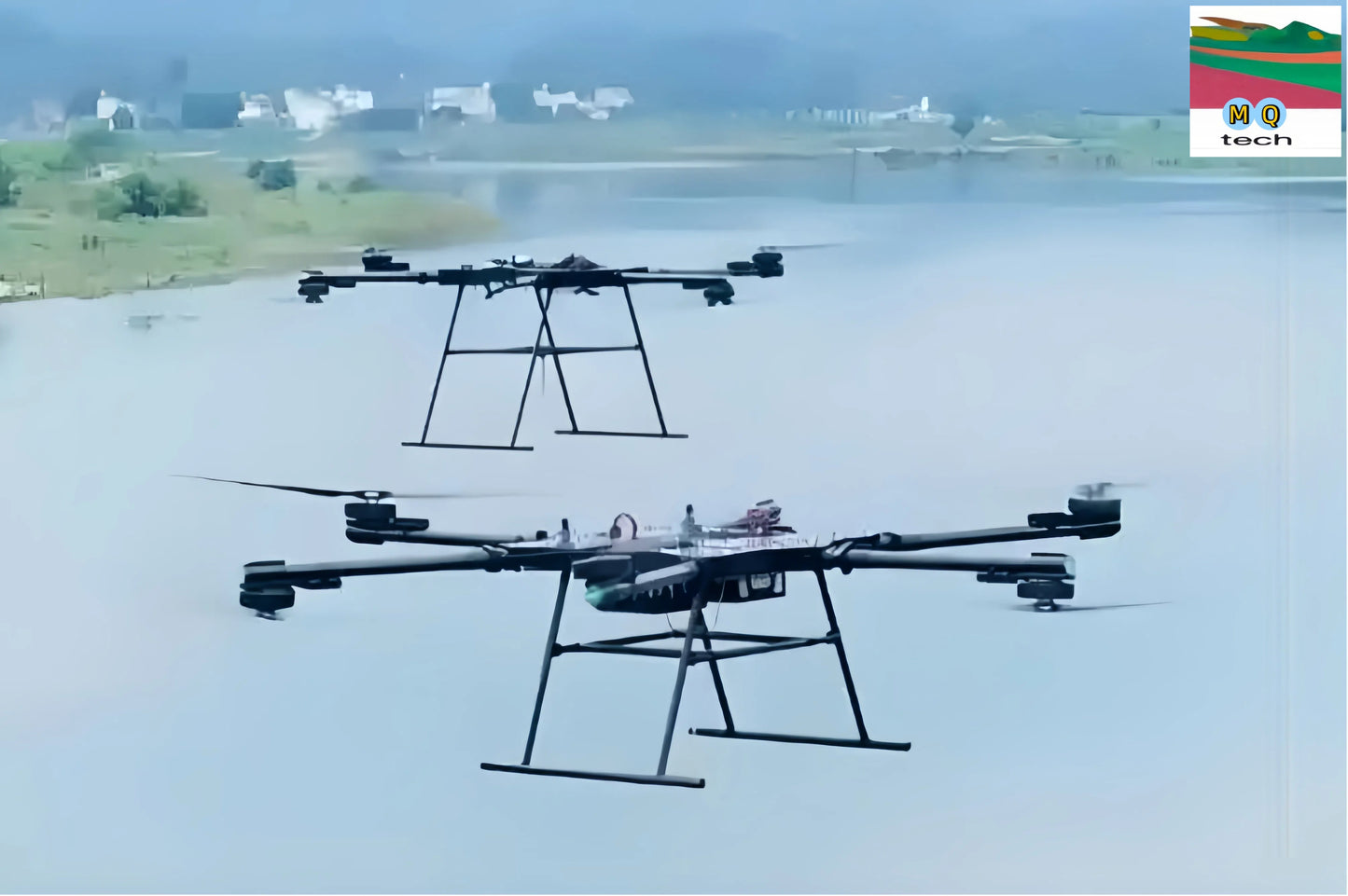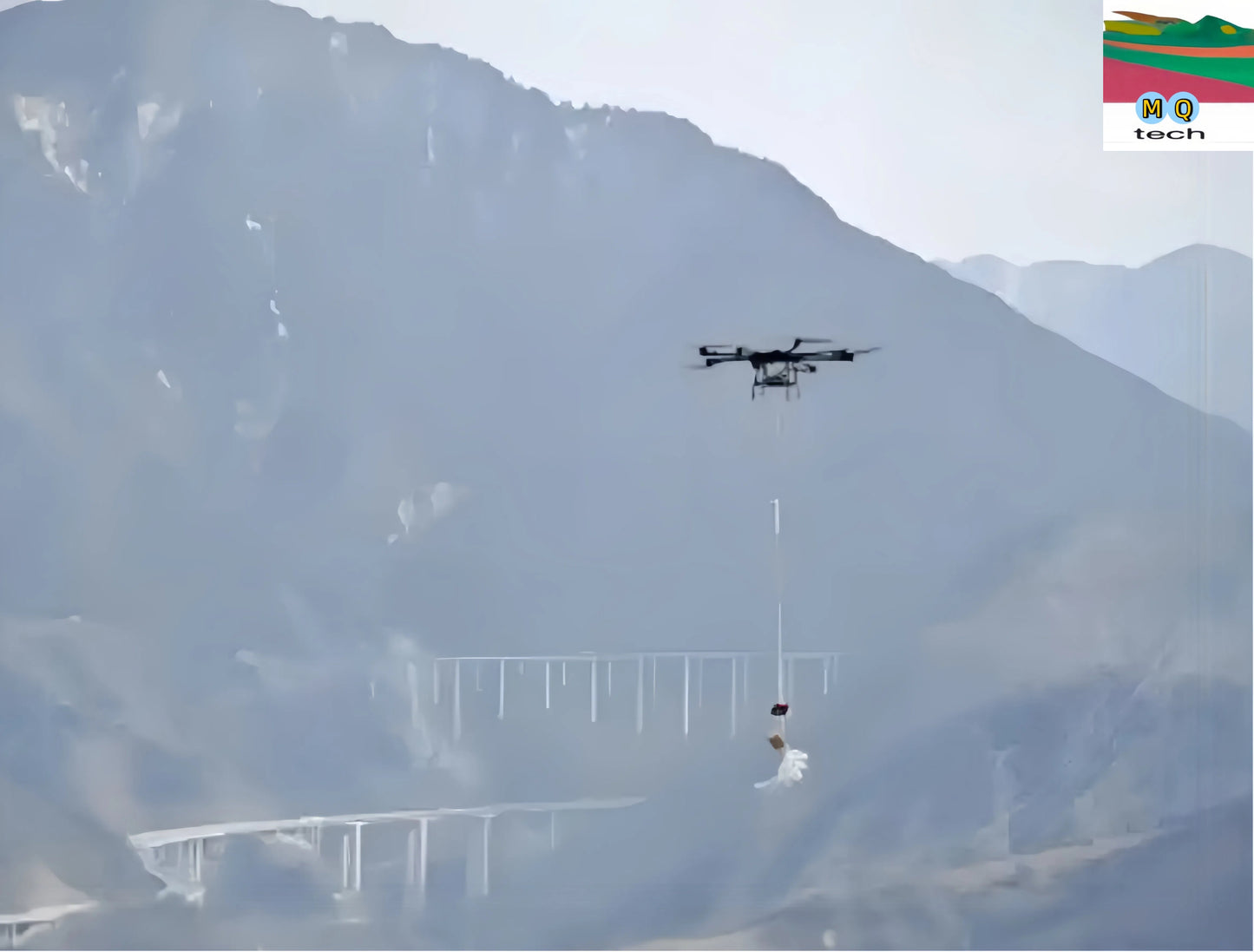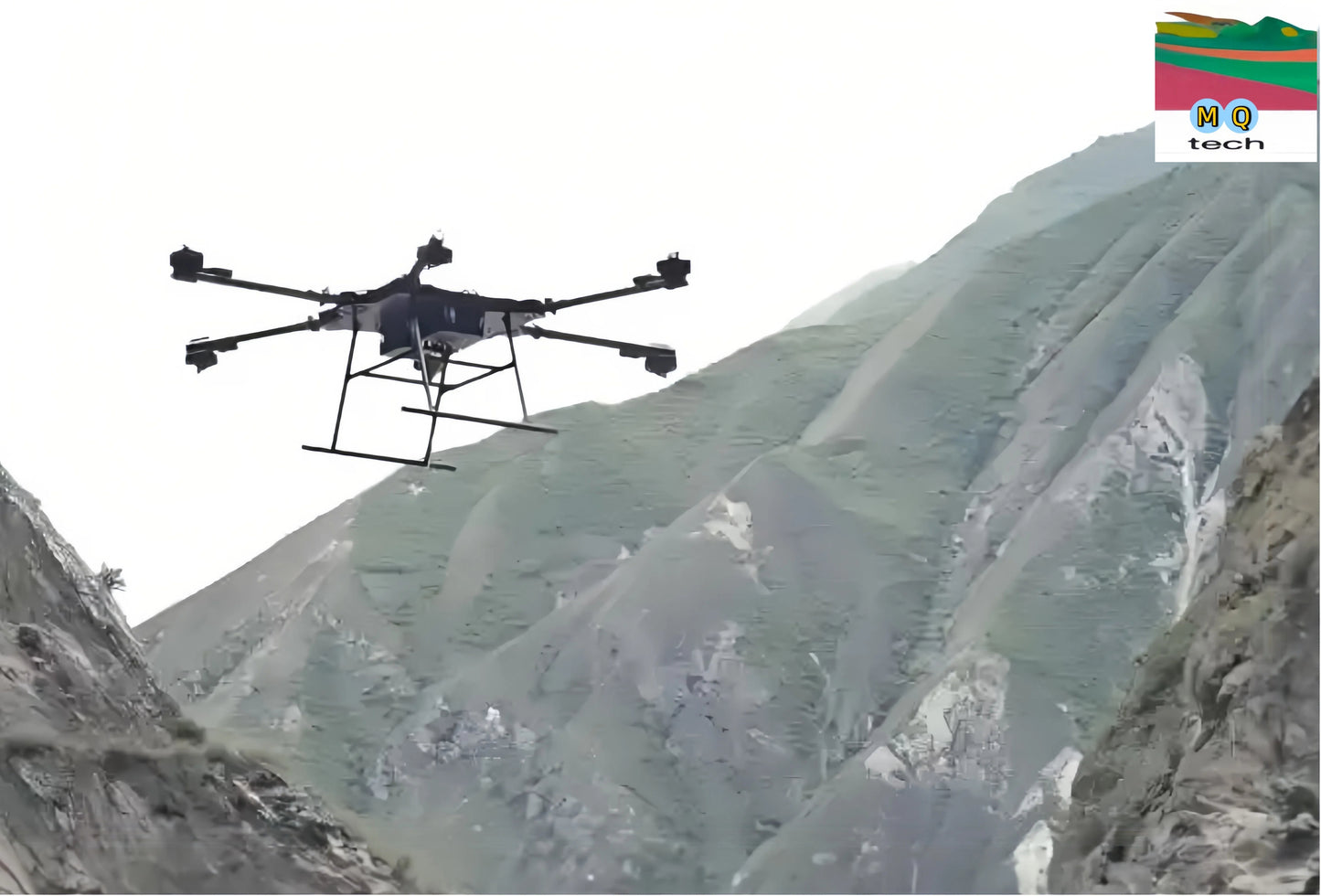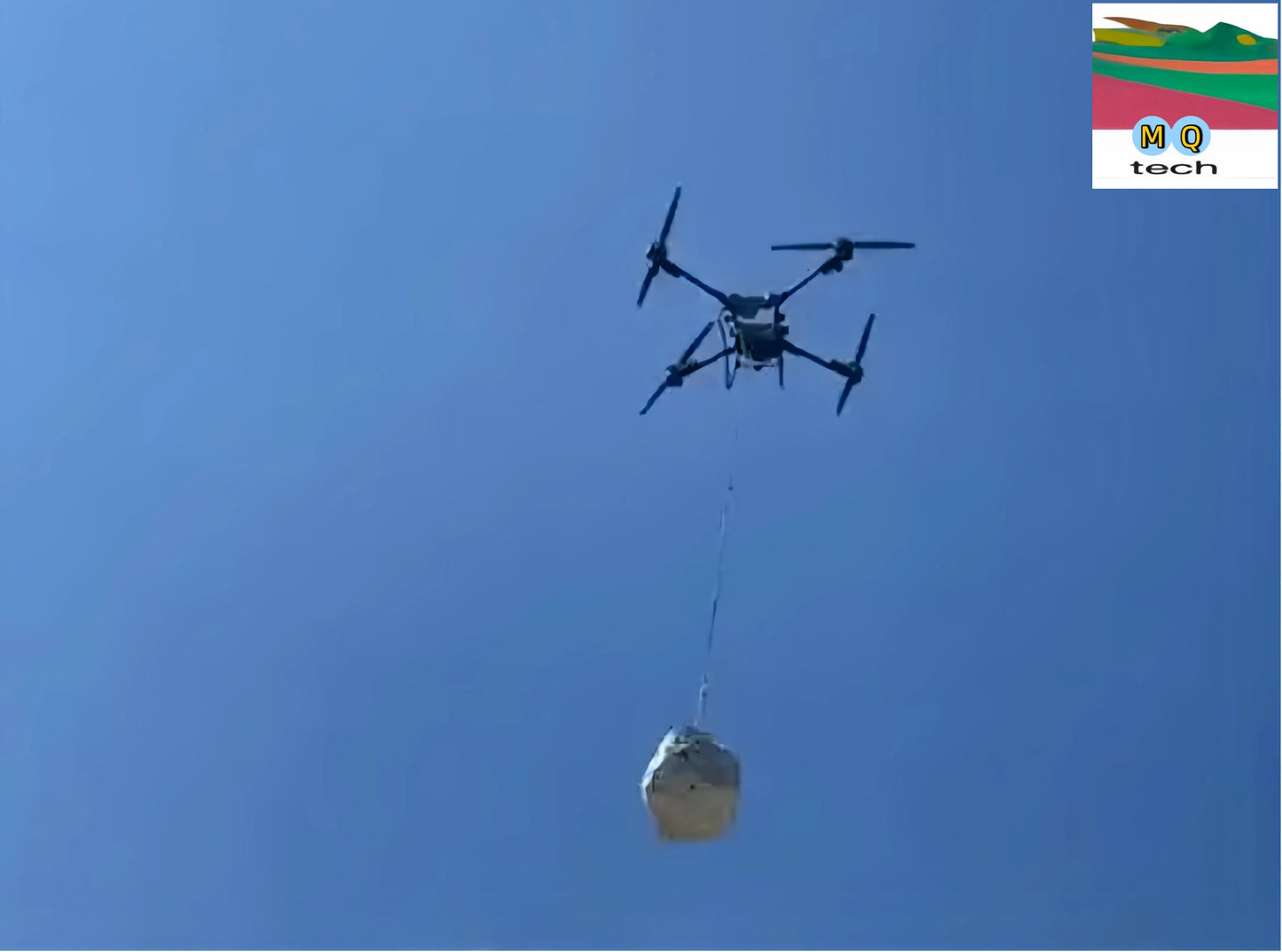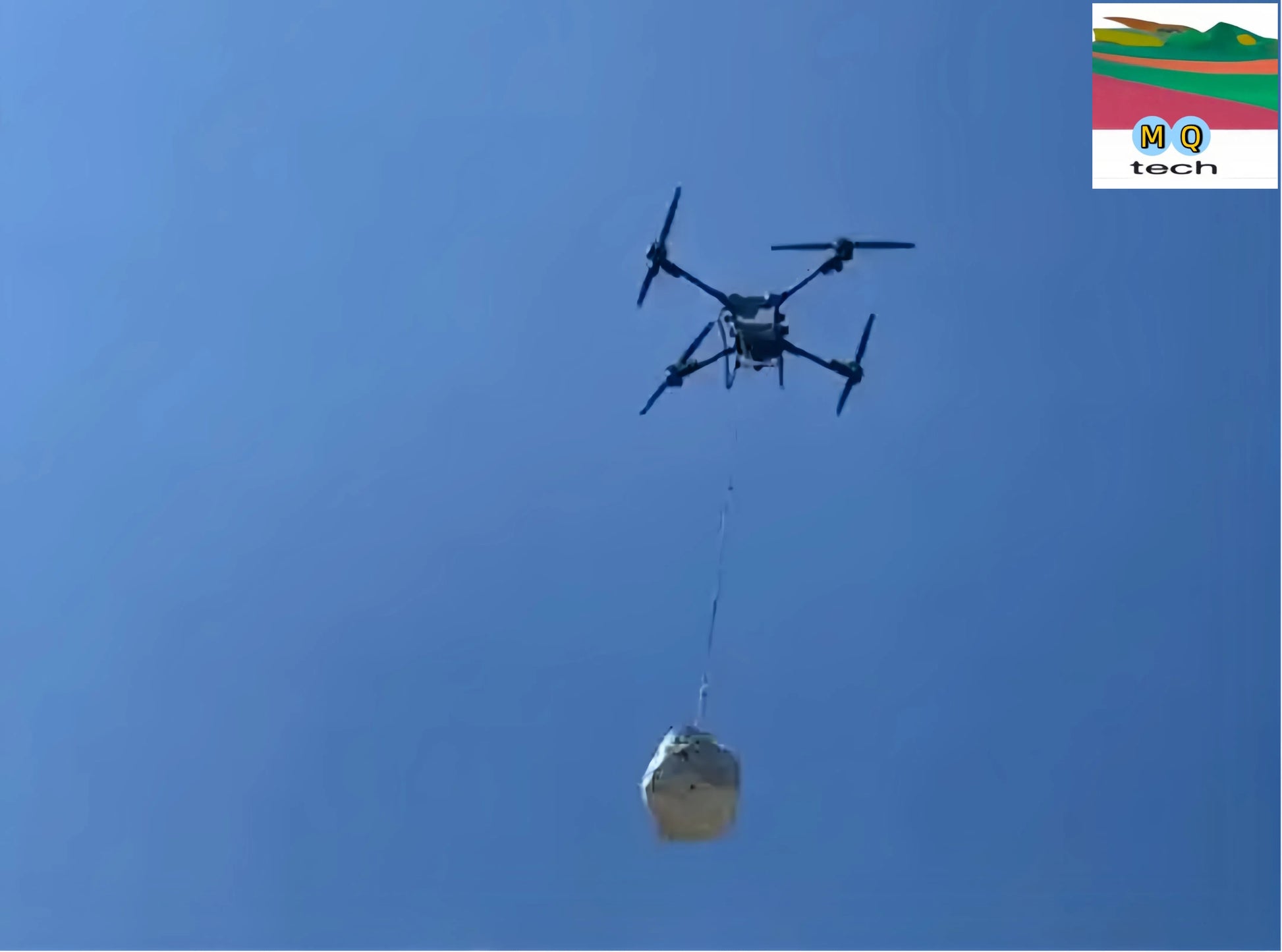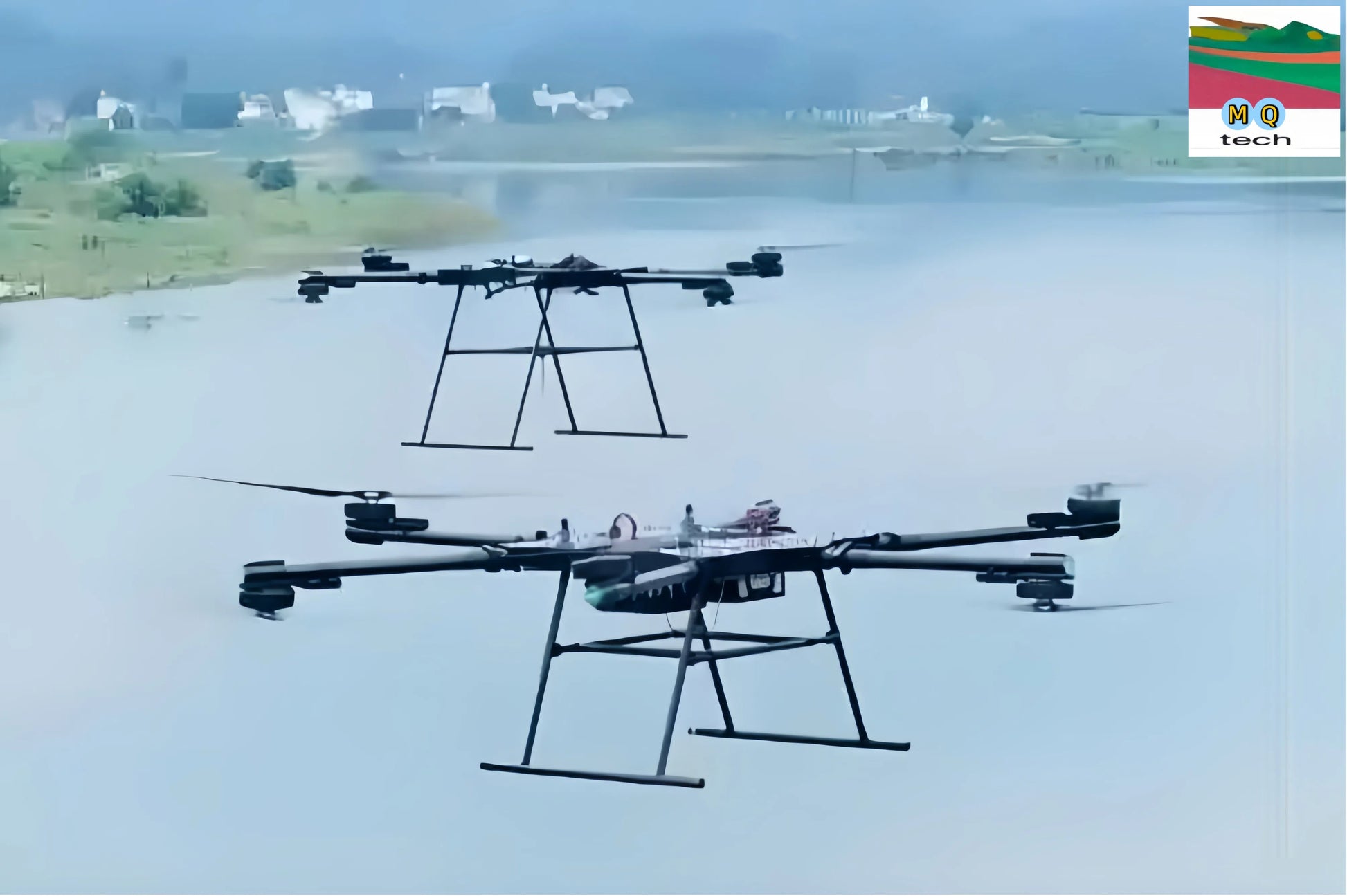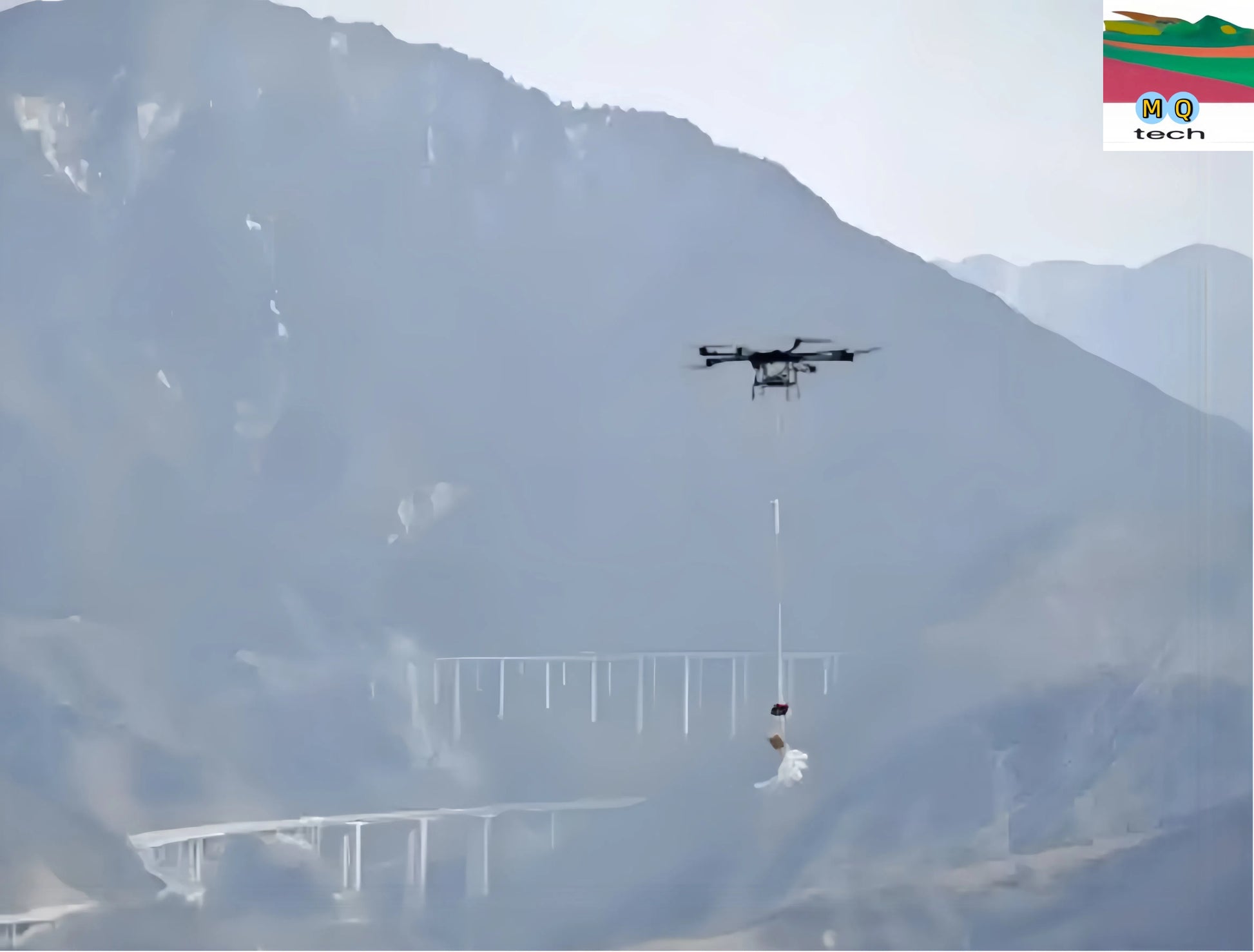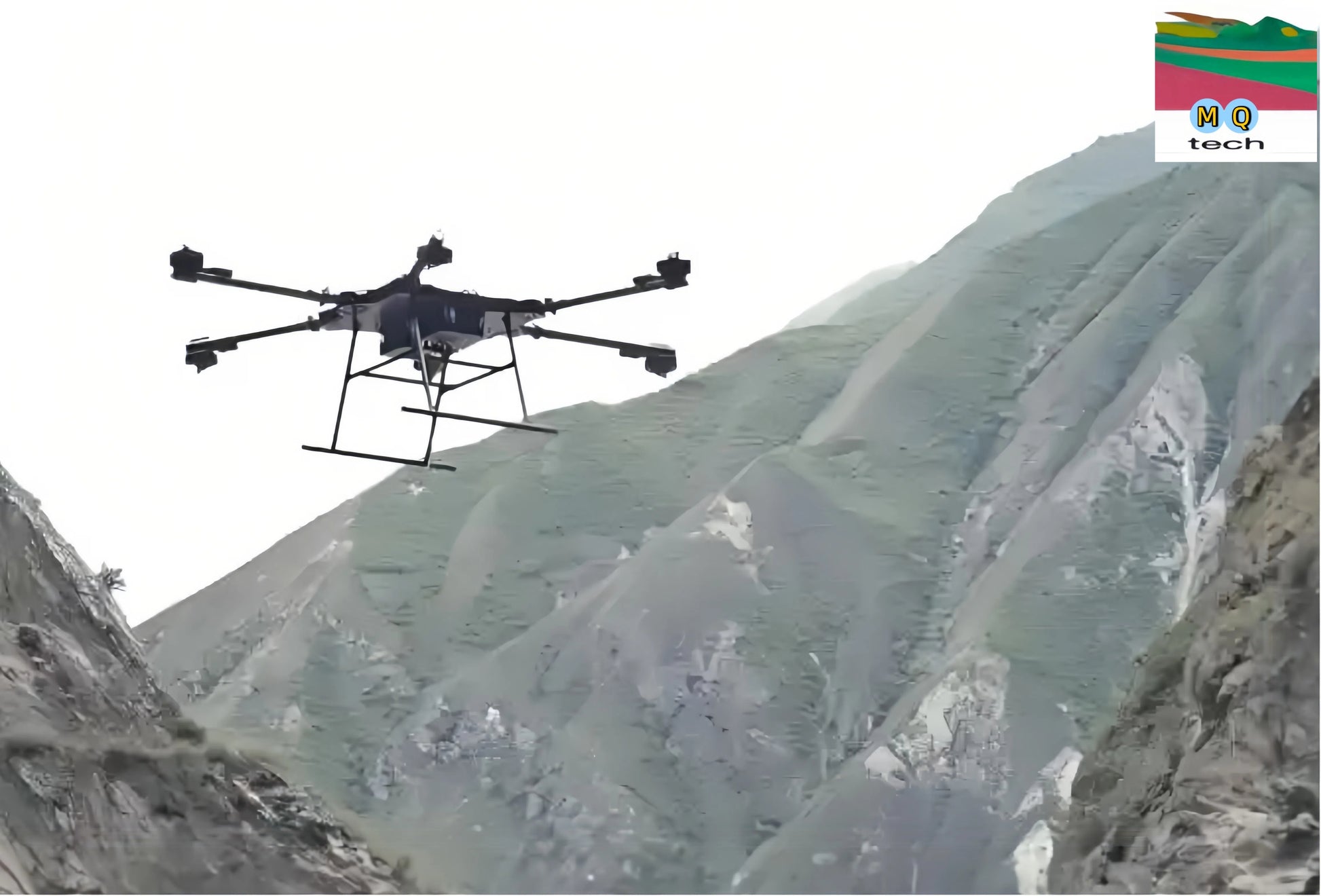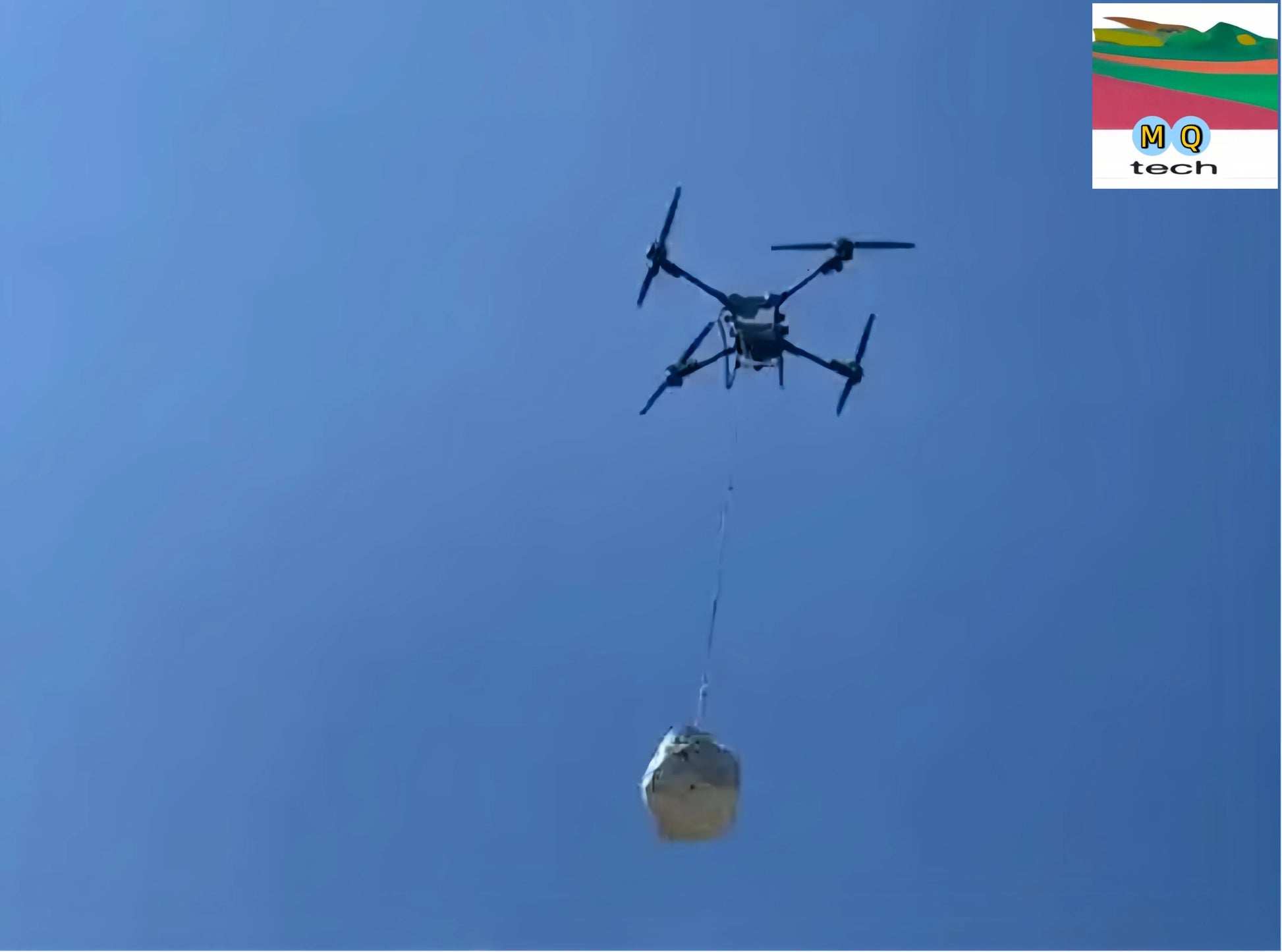Miaoqiang tech
MQ-tech 300kg heavy-lift drone
MQ-tech 300kg heavy-lift drone
Couldn't load pickup availability
🚁 MQ-Tech "Giant" Series Heavy-Load UAVs - Redefining Industrial Air Power 🚁
⚡ Extreme Performance, Unpredictable
► 300kg Incredible Payload: Single-use suspension for small cars or complete industrial equipment, overcoming traditional transportation limitations!
► Intelligent Adaptive Propulsion System: Eight-axis redundant design ensures stable landing even with dual motor failure, with a safety level comparable to aviation standards.
► 120-minute Ultra-Long Flight Endurance: Equipped with a fuel-assisted power system, it offers stress-free field operations.
🌐 Full-Scenario Solution
✔ Infrastructure Fanatic Assistant: Lifting bridge steel structures and high-altitude docking of wind turbine blades with centimeter-level accuracy!
✔ Emergency Rescue Pioneer: Rapidly deliver disaster relief supplies and establish temporary communication base stations in complex environments.
✔ Island Logistics Expert: Direct access to ships and offshore platforms without port terminals, reducing transportation costs by 70%!
🔝Technology Core, Precision Control
AI Autonomous Obstacle Avoidance 3.0: Millimeter-wave radar + laser sensing, capable of all-weather operations in nighttime and dense fog
Cloud-based cluster scheduling: Supports synchronized formation of hundreds of drones, generating coordinated operation plans with one click
Carbon fiber unibody: 30% lighter than the industry average, with an impressive payload ratio of 1:1.5
🎯Now open for global industry collaboration!
👉 Message us for a customized solution + a free test flight demonstration
👉 First customers enjoy an extended 3-year warranty and AI-powered operations support
🚀Immediate ROI:
"After implementing MQ-Tech, a port saw a 210% increase in daily loading and unloading efficiency and a 45% reduction in labor costs." - Data source: third-party audit report
I. Performance and Flight Capabilities
What is the maximum payload? Is the 300 kg net payload, or does it include the hardpoints/fixtures? → The nominal payload of this model is 300 kg net payload, which refers to the weight of the cargo that can be transported and does not include the weight of the standard hardpoints, straps, or cargo hold fixtures. If the customer requires hardpoints to be included in the payload, please provide the specific configuration when placing the order. The manufacturer will provide two sets of data sheets, "gross payload" and "net payload," for verification.
What is the maximum endurance/range when fully loaded (300 kg)? → Under full load, endurance and range are affected by the selected powertrain (pure electric/hybrid/fuel), weather conditions, and route profile. Typical configurations: Pure electric short-range models have a range of approximately 30–60 minutes (depending on battery energy density); hybrid or fuel versions can achieve a fully loaded cruising range of 2–6 hours or 100–800 km. Before signing a purchase order, we will provide a third-party-verified "full-load operating range chart" based on the selected configurations and mission profile.
What are the maximum cruise speed and maximum cruising altitude when fully loaded? → A fully loaded cruise speed is generally slower than an empty one. For reference: Cruise speed is typically 60–160 km/h (depending on aerodynamic configuration and power); maximum service altitude is typically 3,000–6,000 meters AMSL (depending on engine and aerodynamic design). We will provide speed/climb performance charts for fully loaded and partially loaded aircraft upon purchase.
Is the aircraft capable of vertical/short takeoff and landing (VTOL/STOL)? What landing area is required? → Both VTOL and fixed-wing STOL versions are available. The VTOL version does not require a runway, but does require a vertical landing radius (including safety margins) of approximately 6–20 meters in diameter and a solid landing surface. The STOL version requires a short runway of approximately 50–300 meters, depending on payload and environmental conditions (altitude/wind speed). We will provide minimum landing area specifications based on the installed configuration.
What is the climb rate and time required to reach a specified altitude when fully loaded? → The fully loaded climb rate is typically between 1–5 m/s (lower for VTOL and multi-rotor solutions, higher for fixed-wing with boost). For example, a climb from ground level to 500 m typically takes 2–10 minutes, depending on engine power and weather conditions. A specific load-based climb curve should be provided at the time of purchase to facilitate mission planning.
Does the aircraft support long-range missions (BVLOS) and how many kilometers can it travel? → Yes, it supports BVLOS (depending on optional communications and regulatory approvals). Hybrid/fuel-powered versions can support BVLOS missions of hundreds of kilometers, provided they have the appropriate links and regulatory approvals. Pure electric versions are limited by battery life. BVLOS also requires ground control, link redundancy, and an emergency return strategy. We can provide a complete BVLOS solution and assist with regulatory approval applications.
What is the wind/turbulence resistance level (e.g., what wind speed can it withstand)? → The aircraft is designed with a rated wind resistance, with typical safe operating wind speeds of 8–12 m/s (equivalent to approximately Beaufort class 5–6); short-term surge and gust resistance will be higher. It is recommended to limit fully loaded takeoff and landing to lower wind speeds. Wind tunnel or field-measured data and an operational wind speed chart will be provided at the time of purchase.
How does performance change in low/high temperature/high altitude environments? → High temperatures reduce engine air intake/battery performance, low temperatures affect battery discharge capacity, and high altitudes reduce air density, thus affecting lift and engine power. We provide an environmental correction factor table listing load-range correction values for temperatures between -20°C and +50°C and at various altitudes. We can also provide cold/high altitude modification packages (such as heated battery boxes and pressurization systems) upon request.
II. Power and Energy Systems
Will it use a battery, hybrid, or fuel engine? Are there any options? → This platform supports three powertrain options: pure electric (zero emissions, low noise, and easy maintenance), hybrid (diesel generator + electric propulsion, balancing range and efficiency), and pure fuel (maximum range with fast refueling). Customers can select or customize the powertrain based on mission requirements.
Battery type, single battery life, charging time, and replacement/hot-swappable battery options? → Standard configuration uses high-energy-density lithium-ion power batteries (sodium-ion/solid-state batteries upon request). Single battery capacity and endurance vary depending on the aircraft model. For example, a single battery pack in one configuration can support a full load in 30–45 minutes; charging time varies from 1 to 6 hours depending on the charging power. Fast charging and ground-based hot-swappable battery packs are supported (standardized quick-change interface), allowing for ground-based replacement within 5–15 minutes.
Is in-flight battery swapping/quick battery swapping or ground-based quick battery swapping supported? → Ground-based quick battery swapping is supported (modular design) and an optional automatic battery swap station is available. In-flight battery swapping is a highly complex solution, requiring dedicated battery swapping vehicles and regulatory approvals. Currently, ground-based battery swapping or hybrid solutions are generally used to meet long-range flight requirements.
What are the fuel consumption and maintenance intervals for the fuel/engine versions? → Fuel consumption depends on engine power and mission profile. A guideline value: Fuel consumption under cruise conditions can be 5–30 L/h (for small turboprop/internal combustion with generator). Routine maintenance: Intermediate/overhaul inspections are performed every 50–200 hours, and major components (engines) are maintained according to the manufacturer's manual. The manufacturer will provide a detailed maintenance manual and component life chart.
Is there energy redundancy (dual power supply, dual fuel system) to enhance safety? → Energy redundancy (dual independent power supply channels, dual engines/dual fuel circuits, or a hybrid redundancy solution) is available as an option to ensure return to home or safe emergency landing in the event of a single point of failure. The redundancy level can be customized based on the customer's mission-criticality (e.g., rescue/passenger cargo).
III. Safety and Redundancy Design
Does the aircraft have dual/triple redundant flight control and transmission systems? → Standard redundancy of key subsystems: primary and backup flight control, dual-channel sensor fusion, and optional dual-motor or multi-motor configurations for the critical propulsion chain. The mission-critical version offers triple redundancy (TMR) to reduce the risk of single points of failure.
What are the active/passive obstacle avoidance and perception systems (radar, optical, infrared, and LiDAR)? → Supports multi-sensor fusion: forward/downward-looking stereo cameras, onboard radar, high-precision LiDAR scanning (optional), and infrared thermal imaging (for nighttime and low-visibility situations). Obstacle avoidance logic supports real-time point cloud, dynamic target tracking, and autonomous avoidance route replanning.
What are the emergency landing/ejection/parachute systems for emergencies (loss of control, chain break, engine failure)? → Depending on weight and regulations, options include: automatic return/holding mode, controlled glide return, an onboard parachute system (a larger parachute is required for the 300 kg class, taking into account structural strength and regulatory considerations), and single-engine redundancy strategies for fuel engine failure. Emergency plans will be confirmed with the customer before delivery and included in the operating manual.
Are flight recorders (black boxes) and data playback functions equipped? → The flight recorder is standard, recording flight attitude, telemetry, sensor data, and video (optional), with export and playback tools to facilitate accident investigations and maintenance analysis. Recordings meet traceability and compliance requirements.
What safety measures are in place for fire, explosion, and leakage prevention (for dangerous goods transport)? → For dangerous goods transport, we offer: isolated cargo holds, leak-proof pallets, explosion-proof cabin designs (based on the type of dangerous goods transported), cargo hold temperature and pressure monitoring and automatic shut-off systems, and optional mandatory fire-retardant materials and fire-extinguishing systems. Dangerous goods transport is subject to local regulations and special permits.
How do load securing, shock and vibration resistance, and cargo hold sealing solutions ensure cargo safety? → The cargo hold offers standardized fixing interfaces (pallet anchors, ISO-compliant clamps), shock-absorbing mattresses, and active damping fixtures. The cargo hold offers optional airtight, dust-proof, and waterproof sealing, and supports cold chain insulated containers or inert atmosphere containers to protect cargo from mechanical shock and environmental impact during transport.
IV. Regulations and Compliance
What flight permits and operating licenses are required for the target operating area (city, inter-county, inter-province, or international)? → Permits vary by country and region. Generally, the following are required: an operator's certificate (Operator's Certificate/COA) from the civil aviation or drone regulatory agency, a BVLOS operating permit, an airspace use permit, a noise and environmental compliance certificate, and a temporary airspace permit from the local government. International transport also requires customs and import and export permits. We can assist clients with filing and provide compliance consulting.
Are there any successful examples of airworthiness/operational certification from civil aviation/traffic management authorities? → We can provide certified pilot/customer cases (if available), as well as third-party test flight reports and certification document samples for reference. Upon request, we can assist with airworthiness verification or participate in regulatory pilot projects.
What are the regulatory compliance capabilities for night flights, BVLOS, and flights over crowded/urban areas? → Technical support is available (equipped with nighttime lighting, ground coordination, obstacle avoidance, and link redundancy), but this must be carried out under regulatory approval. We can support your application by providing a compliance operations manual, risk assessment (SORA/similar approach), and required hardware (e.g., anti-collision lighting, emergency landing site planning).
Does the product comply with local laws and regulations regarding noise, emissions, and hazardous materials transportation? → We consider noise and emissions limits in major markets during design and testing, and can provide noise measurement reports, emissions test data, and hazardous materials transportation compliance certificates. If the target market has specific standards, we can provide customized designs to meet local regulations.
Are export controls or military restrictions (ITAR/other) involved in export/international sales? → Some sensors, encrypted communications, or military-grade components may be subject to export controls (e.g., ITAR, EAR, or local equivalents). We will conduct a component compliance review before sale, inform customers of configurations that may require export licenses, and assist with preparing license documentation or providing non-controlled alternatives.
V. Transportation, Loading, and Logistics Integration
Cargo hold dimensions, accessibility (top/side), and support for cold chain or temperature-controlled transportation? → The cargo hold is modular, and standard cargo hold dimensions and accessibility (side/top) are configurable. It supports cold chain modules (refrigeration/insulation boxes), temperature sensing, and remote monitoring, making it suitable for transporting pharmaceuticals and perishables. Detailed dimensions and module lists are provided in the technical manual.
What are the interfaces/standards (pallets, containers, hooks) for securing and quickly loading and unloading cargo? → ISO/industry-standard pallet interfaces, quick-lock systems, and electrical/data interfaces are provided, compatible with common logistics pallets and containers. Customized hook or sling interfaces are also supported to meet on-site loading and unloading efficiency requirements.
Does it support on-demand delivery, precision delivery, or airdrop? What is the accuracy (meter-level/decade-level)? → It supports multiple delivery methods: door-to-door drop, winch-to-lower, and precision airdrop. Accuracy depends on the load, wind speed, and positioning system: RTK/differential GNSS and guided delivery can achieve meter-level accuracy; standard GPS is decade-level or worse. Deployment requires secure ground control and legal approval.
Can it be integrated with existing warehouse/logistics management systems (WMS/TMS)? → Providing APIs/SDKs and standard data interfaces (REST, MQTT) supports integration with mainstream WMS/TMS, and ERP systems, facilitating order placement, shipping tracking, and automated task scheduling.
Can multiple aircraft operate in parallel formations (formation transport)? → Supporting multi-aircraft formations/formation control enables parallel capacity scheduling and coordinated delivery. Formation control requires additional formation management software and communication link redundancy, and must meet the airspace management authority's formation flight approval requirements.
VI. Maintenance, Reliability, and Life Cycle
Mean Time Between Failures (MTBF) and lifespan of major components (motor, transmission, engine, battery)? → MTBF and lifespan are affected by usage intensity: reference values are 5,000–20,000 hours for motors, several thousand hours for transmission components depending on gear/bearing specifications, engine overhaul every 1,000–2,000 hours according to the manufacturer's manual, and battery life is typically 500–1,500 cycles (or equivalent). We provide lifespan predictions and replacement recommendations for key components before delivery.
What are the routine maintenance items, maintenance intervals, and annual overhaul intervals? → Routine maintenance: Routine inspections (tightening, electrical testing, transmission lubrication) every 50–200 flight hours; major maintenance and functional verification annually or every 1,000 hours; engine/transmission overhaul intervals according to the manufacturer's manual. A detailed maintenance plan will be delivered with the equipment and included in the maintenance manual.
What maintenance skills and training are required? Does the manufacturer provide training and on-site support? → A ground crew with basic aviation/mechanical maintenance skills is required. The manufacturer provides operator and maintenance training, online and on-site courses, maintenance manuals, and overhaul tool kits. On-site support and spare parts inventory can also be provided upon request.
What are the spare parts supply cycles and whether there is local inventory or partner service locations? → We recommend local inventory of key spare parts (battery packs, engine filters, and key electronic modules). Standard spare parts delivery is typically 1–4 weeks (depending on the region). Local service partners or express delivery contracts can be established to shorten response times.
What are the service life (SLA) and warranty terms (including components and exclusions)? → The standard warranty period is 12–24 months (or per flight hour), covering key components such as the structure, flight control system, and propulsion system, and excluding damage and unauthorized modifications. Extended warranties and rapid response SLAs (e.g., remote support within 48 hours or onsite response within 72 hours) are available. Specific terms can be specified in the purchase contract.
VII. Cost and Business Model
What is the price range for a single aircraft (basic version, commercial version, or customized version)? → The price is significantly affected by the configuration. Here's a guideline (for reference only): Basic commercial versions range from hundreds of thousands to millions of USD; high-end customized or military/special mission versions are more expensive. The final quote will be based on the configuration (powertrain, sensors, certification, training, and service).
What is the estimated operating cost (energy consumption per hour/per kilometer, maintenance, and personnel)? → Operating costs are composed of energy, maintenance, personnel, and depreciation. For example, pure electric vehicles have lower energy costs but require more frequent battery replacements, while hybrid/fuel-powered vehicles have higher energy costs but offer longer ranges. Typical hourly operating costs range widely (tens to hundreds of dollars per hour). We can provide a detailed LCC (Life Cycle Cost) model based on the customer's mission profile.
Do you offer financing leases, fee-per-mission, or UaaS (UAV as a Service) models? → We support a variety of business models: direct sales, financing leases, fee-per-mission/hourly rentals, and UaaS (Drones as a Service). We can negotiate customized commercial terms with customers to reduce their upfront investment.
What are the approximate costs of taxes and insurance (third-party liability insurance, cargo insurance)? → Taxes and insurance vary significantly depending on the country, operating environment, and coverage. It is generally recommended to purchase third-party liability and cargo insurance. Premiums are estimated based on the type of operation and coverage (ranging from thousands to hundreds of thousands of dollars per year). We can recommend compliant insurance plans and provide quotes.
What about depreciation and secondhand residual value? → Depreciation is calculated based on accounting policies and usage intensity. Generally, electronics and batteries depreciate faster (3–5 years), while the airframe structure has a longer lifespan. Secondhand residual value depends on maintenance records and market demand. Well-maintained airframes can retain a higher residual value in the secondhand market. We provide residual value assessment models for financial planning.
VIII. Controls, Automation, and Data
Does the aircraft support fully autonomous flight, semi-autonomous flight, or requires manual remote piloting? Is there a ground control station (GCS)? → Three operating modes are supported: manual remote control, semi-autonomous (human-machine collaboration), and fully autonomous route execution. A portable ground control station (GCS) is provided, supporting mission planning, monitoring, and emergency takeover.
What about the ground control station and remote control range, and link redundancy (4G/5G, satellite, dedicated wireless)? → Multiple link redundancy options are available: dedicated wireless link (short-range, low-latency), 4G/5G cellular backup, and satellite link for long-range BVLOS. Link redundancy and encryption ensure data and control reliability and security.
Are there mission planning, flight simulation, route optimization, and operations management platforms? → Mission planning software and flight simulators are provided for training, as well as route optimization algorithms and operations management platforms (including scheduling, task dispatching, capacity allocation, and log archiving). Cloud or on-premises deployment is supported.
How are data logs, sensor logs, and video/telemetry stored and downloaded? Is encrypted transmission supported? → Data logs support local storage (removable memory cards), real-time edge upload, and cloud storage backup. All links and storage can be configured with optional encryption methods such as AES to ensure secure transmission and storage. Access rights management and audit logs are also supported.
Does the system provide APIs or SDKs for integration with third-party systems? → Developer APIs/SDKs (REST, WebSocket, MQTT, etc.) and development documentation are provided to facilitate deep integration with WMS/TMS, scheduling systems, or in-house platforms. Further development and plugin expansion are supported.
IX. Payloads and Special Applications
Does the system support specialized modules for cold chain (pharmaceutical) transportation, hazardous materials transportation, relief supplies, and express parcel shipping? → Supports specialized modular cargo holds: cold chain containers, hazardous chemical isolation chambers, rescue drop chambers, and standard express delivery modules. Each module has corresponding safety and monitoring measures and requires transportation permits in accordance with relevant regulations.
Are optional mounts (lifting, hoisting, and dropping) and additional actuators (grabbing arms) available? → Lifting/hoisting/dropping devices and optional grabbing arms (robotic arms, remote hooks) are provided, along with load control software to ensure lifting stability and positioning accuracy. Actuators are customized for each task and have passed strength and safety testing.
What are the maximum item size and shape restrictions? How many small packages can be carried at a time? → The maximum item size is limited by the cargo hold or mount interface; modular pallets can carry multiple small packages, the specific number depending on the package volume and weight distribution. We will provide cargo hold layout plans and typical loading examples.
Can custom devices such as cameras, sensors, communication relays, or advertising screens be installed? → Standardized power and data bus interfaces are provided to facilitate the installation of additional cameras, sensors, communication relays, or lightweight advertising displays. Secondary development must be conducted within the scope of factory certification or licensing.
10. Personnel and Training
What qualifications/certifications are required for operators, and what is the training duration? Are training materials and simulators provided? → Operators must obtain drone operation certification (e.g., remote pilot license, rating certificate, etc.) as required by the local civil aviation/regulatory agency. The manufacturer provides introductory and advanced training courses, training materials, certification exam preparation, and flight simulators. The standard training period ranges from several days to several weeks, depending on the position and level of authority.
Is a ground crew (loading, unloading, and inspection) required? What is the recommended staffing ratio and workflow? → Large aircraft typically require a ground crew (2–6 people): loaders/riggers, safety inspectors, ground controllers, and maintenance technicians. It is recommended to develop standardized ground handling procedures (pre-operation inspection, loading/securing, takeoff and landing coordination, recovery, and maintenance), and provide operational SOPs upon delivery.
Is there specialized training for duty, nighttime, and harsh environments? → Provide specialized training for nighttime/harsh environment operations (covering night vision regulations, low-visibility operations, cold-region maintenance, and emergency response), and equip the appropriate tools and emergency procedures.
XI. Insurance, Liability, and Safety Compliance
Does the manufacturer require or provide a pre-operation risk assessment and insurance plan? → The manufacturer recommends and can assist in completing a pre-operation risk assessment (SORA or local equivalent) and recommend appropriate insurance plans (third-party liability, cargo insurance, and property damage insurance). The manufacturer can assist in liaising with insurance partners and provide the necessary technical documentation for insurance.
If third-party damage or cargo loss occurs, how is liability allocated? → Liability allocation is based on contract terms, operational compliance, and accident investigation results. Common clauses: Liability for damages caused during the warranty period/factory failure is the manufacturer's responsibility; losses caused by human error or unauthorized modifications are the operator's responsibility. It is recommended that the purchase contract clearly define responsibilities and claims procedures, and that appropriate insurance be purchased.
Is there an accident log and recall mechanism? What is the historical accident rate? → The company maintains and reports accident/abnormal records and has a product safety incident response and recall mechanism (including notification, downgrade/grounding measures, and remediation plans). Specific historical accident rates will be provided to potential customers for reference after due diligence or NDA submission.
XII. Application Cases and Verification
Are there customer case studies, third-party test reports, flight test videos, or field verification data? → We can provide decrypted customer case studies, third-party performance test reports, flight test videos, and field engineering test data to demonstrate performance in similar missions. We can provide case packages or arrange site visits/flight tests upon request.
Can flight tests/POCs be arranged (under what conditions and at what cost)? → We support flight test/POC services. Typical conditions include signing a confidentiality agreement/liability waiver, site and regulatory approvals, and daily or project-based pricing (including equipment, crew, maintenance, and data analysis). Specific fees and terms can be determined during the negotiation phase.
What objective data compares similar aircraft models with competitors (advantages/disadvantages)? → We provide comparison tables (including third-party evaluations or public data) with major competitors in terms of payload, range, MTBF, unit operating cost, maintenance ease, and compliance certifications. This comparison will quantify the advantages and limitations and help customers make decisions.
#drone #low-altitude-economy #heavy-load-carrying-drone #drone-lifting #entrepreneurship
Share
